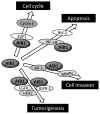The role of AIB1 in breast cancer
- PMID: 23226788
- PMCID: PMC3506592
- DOI: 10.3892/ol.2012.803
The role of AIB1 in breast cancer
Abstract
Amplified in breast cancer 1 (AIB1) is a member of the p160 steroid receptor coactivator family that mediates the transcriptional activities of nuclear receptors including estrogen receptor (ER) and progesterone receptor (PR), as well as certain other transcription factors, including E2F1 and p53. AIB1 is widely implicated in nuclear receptor-mediated diseases, particularly malignant diseases, including breast, prostate, gastric and pancreatic cancers. AIB1 was initially implicated in hormone-dependent breast cancer, where increasing levels of AIB1 mRNA and protein were detected in some of these specimens and the overexpression of AIB1 in mice led to an increased incidence of tumors. More recent studies revealed that AIB1 also affects the growth of hormone-independent breast cancer via signaling pathways such as those of E2F1, IGF-I, EGF and PI3K/Akt/mTOR. The pleiotropic effect of AIB1 and the roles it plays in both normal development and cancer have presented a great challenge to formulating an effective therapeutic strategy for breast cancer. In this review, we highlight the significant progress made with the recent findings and present an overview of the current understanding of the influence of AIB1 on breast cancer via hormone-dependent and -independent signaling pathways.
Figures



Similar articles
-
The role and regulation of the nuclear receptor co-activator AIB1 in breast cancer.Breast Cancer Res Treat. 2009 Jul;116(2):225-37. doi: 10.1007/s10549-009-0405-2. Epub 2009 May 6. Breast Cancer Res Treat. 2009. PMID: 19418218 Free PMC article. Review.
-
Expression of AIB1 protein as a prognostic factor in breast cancer.World J Surg Oncol. 2011 Oct 29;9:139. doi: 10.1186/1477-7819-9-139. World J Surg Oncol. 2011. PMID: 22035181 Free PMC article.
-
Altered AIB1 or AIB1Δ3 expression impacts ERα effects on mammary gland stromal and epithelial content.Mol Endocrinol. 2011 Apr;25(4):549-63. doi: 10.1210/me.2010-0114. Epub 2011 Feb 3. Mol Endocrinol. 2011. PMID: 21292825 Free PMC article.
-
Amplified in breast cancer 1 in human epidermal growth factor receptor - positive tumors of tamoxifen-treated breast cancer patients.Clin Cancer Res. 2007 Mar 1;13(5):1405-11. doi: 10.1158/1078-0432.CCR-06-1933. Clin Cancer Res. 2007. PMID: 17332282
-
SRC-3 has a role in cancer other than as a nuclear receptor coactivator.Int J Biol Sci. 2011;7(5):664-72. doi: 10.7150/ijbs.7.664. Epub 2011 May 24. Int J Biol Sci. 2011. PMID: 21647249 Free PMC article. Review.
Cited by
-
Cancer Stem Cell Phenotypes in ER+ Breast Cancer Models Are Promoted by PELP1/AIB1 Complexes.Mol Cancer Res. 2018 Apr;16(4):707-719. doi: 10.1158/1541-7786.MCR-17-0598. Epub 2018 Jan 18. Mol Cancer Res. 2018. PMID: 29348189 Free PMC article.
-
The Intrinsically Disordered Region of HBx and Virus-Host Interactions: Uncovering New Therapeutic Approaches for HBV and Cancer.Int J Mol Sci. 2025 Apr 10;26(8):3552. doi: 10.3390/ijms26083552. Int J Mol Sci. 2025. PMID: 40332052 Free PMC article. Review.
-
A forceful connection: mechanoregulation of oncogenic YAP.EMBO J. 2017 Sep 1;36(17):2467-2469. doi: 10.15252/embj.201797527. Epub 2017 Jul 19. EMBO J. 2017. PMID: 28724528 Free PMC article.
-
The role of circadian rhythm in breast cancer.Chin J Cancer Res. 2013 Aug;25(4):442-50. doi: 10.3978/j.issn.1000-9604.2013.08.19. Chin J Cancer Res. 2013. PMID: 23997531 Free PMC article.
-
The estrogen receptor coactivator AIB1 is a new putative prognostic biomarker in ER-positive/HER2-negative invasive lobular carcinoma of the breast.Breast Cancer Res Treat. 2019 Jun;175(2):305-316. doi: 10.1007/s10549-019-05138-7. Epub 2019 Feb 22. Breast Cancer Res Treat. 2019. PMID: 30796653 Free PMC article.
References
-
- Xu J, Li Q. Review of the in vivo functions of the p160 steroid receptor coactivator family. Mol Endocrinol. 2003;17:1681–1692. - PubMed
-
- Anzick SL, Kononen J, Walker RL, Azorsa DO, Tanner MM, Guan XY, Sauter G, Kallioniemi OP, Trent JM, Meltzer PS. AIB1, a steroid receptor coactivator amplified in breast and ovarian cancer. Science. 1997;277:965–968. - PubMed
-
- Torres-Arzayus MI, Font de Mora J, Yuan J, Vazquez F, Bronson R, Rue M, Sellers WR, Brown M. High tumor incidence and activation of the PI3K/AKT pathway in transgenic mice define AIB1 as an oncogene. Cancer Cell. 2004;6:263–274. - PubMed
-
- Kuang SQ, Liao L, Zhang H, Lee AV, O'Malley BW, Xu J. AIB1/SRC-3 deficiency affects insulin-like growth factor 1 signaling pathway and suppresses v-Ha-ras-induced breast cancer initiation and progression in mice. Cancer Res. 2004;64:1875–1885. - PubMed
-
- Kuang SQ, Liao L, Wang S, Medina D, O'Malley BW, Xu J. Mice lacking the amplified in breast cancer 1/steroid receptor coactivator-3 are resistant to chemical carcinogen-induced mammary tumorigenesis. Cancer Res. 2005;65:7993–8002. - PubMed
LinkOut - more resources
Full Text Sources
Research Materials
Miscellaneous
